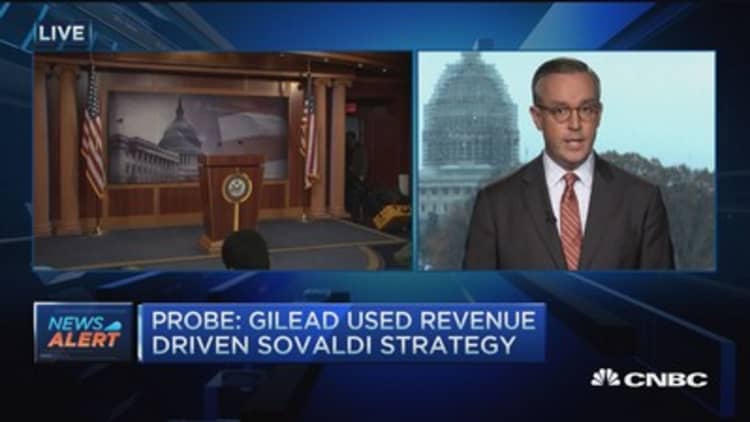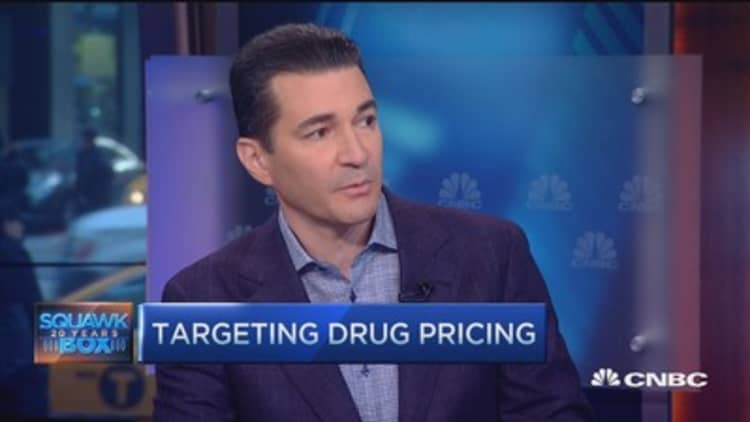A new study from Johns Hopkins University School of Medicine questions whether some of the biggest drug companies and their blockbuster medications are taking advantage of a decades-old act meant to increase research, development and drug approval for people suffering from rare diseases.
Drugs approved by the Food and Drug Administration as "orphan drugs" have seen sales increase from $46.6 billion in 2014 to $54 billion this year in the U.S. alone and are projected by drug industry consultant EvaluatePharma to reach above $60 billion in 2016. Worldwide, orphan drug sales are forecast to total $102 billion this year and $178 billion by 2020.
The 41 percent of all FDA approvals for new drugs in 2014 that were designated orphan drugs compares to six orphan drug approvals of a total 30 new drugs approved by the FDA in 1985 (two years after the Orphan Drug Act, also known as the ODA, was passed).
In 1983, the United States Orphan Drug Act (ODA) was passed in the hope that with more research and a faster approval process, new drugs could be available for "orphan diseases," meaning those that affect less than 200,000 people. The ODA offers drug makers incentives to find treatments for rare diseases, including grants, tax incentives and extension of exclusive marketing rights to a drug for seven years.
"The loophole means more monopoly power for pharma companies selling common drugs that were snuck through the FDA as orphan drugs," Dr. Marty Makary of Johns Hopkins, the lead researcher and senior author of the study, told CNBC.
The new study, published in the American Journal of Clinical Oncology, argues that while the ODA has fostered drug development for patients with rare cancers and other diseases, current data suggest that companies are "gaming the system to use the law for mainstream drugs."
The authors found what they deem "a pattern of pharmaceutical companies submitting drugs to the Food and Drug Administration (FDA) as orphan drugs but once approved, the drugs are used broadly off-label with the lucrative orphan drug protections and exclusivity benefits."
Blockbuster drugs with orphan status
| Drug | Global sales<br> 2015 ($B) | Maker | Therapy<br> area |
|---|---|---|---|
| Humira | 14.1 | AbbVie | Antirheumatic |
| Rituxan | 7.6 | Roche | Cancer antibody |
| Avastin | 7.2 | Roche | Cancer antibody |
| Herceptin | 6.6 | Roche | Cancer antibody |
| Remicade | 6 | Johnson & Johnson | Antirheumatic |
| Revlimid | 5.7 | Celgene | Blood cancers |
| Crestor | 5.2 | AstraZeneca | Statin |
(Note to chart: Seven of the 10 top drugs in global sales have received an orphan indication or designation from the FDA. Designation does not mean the drug has received FDA approval to treat a rare disease. Source: EvaluatePharma.)
In response to the report, Sen. Sherrod Brown (D-Ohio), told CNBC that the ODA was never meant to "pad the profit margins of big pharma." The Ohio senator added, "At a time when rising drug prices are at the top of Americans' health-care concerns, we should be focusing on policies that ensure accessibility and affordability. This means closing the loopholes that pharmaceutical companies have created and ending the abuse of market exclusivity and tax-benefit provisions that exceed the intent of the law."
Sen. Brown has no current plans, though, to introduce legislation to try to close some of those loopholes, according to his spokeswoman.
The study contends that some big drug companies submit a drug for FDA approval with a narrow enough indication that would qualify it for orphan drug benefits. After FDA approval, however, the drug can be used more broadly.
For example, Rituxan (rituximab), which is made by Roche and was initially FDA approved for use in the treatment of follicular non-Hodgkin's lymphoma, is the No. 1 selling medication approved as an orphan drug.
"It is currently used to treat a wide variety of conditions, ranks as the 12th all-time bestselling medication in the United States, and generated over $3.7 billion in U.S. sales in 2014," the report states.
The researchers' concern is not only the "corporate welfare" that is being afforded to blockbuster drugs and highly profitable drug companies, but that "patients with rare cancers and other diseases may suffer due to dilution of the tax incentives and other benefits" offered by the rule to spur the development of niche drugs.
At a time when rising drug prices are at the top of Americans' health-care concerns, we should be focusing on policies that ensure accessibility and affordability.U.S. Sen. Sherrod Brown(D-Ohio)
In 2013, the FDA attempted to reduce a practice known as "salami slicing," or the creation of "new" diseases by classifying more common diseases into various smaller sub-diseases. Slicing disease populations into disease subpopulations can be a maneuver to qualify for the ODA.
But the Johns Hopkins doctors say "the success of this wording change remains to be determined," and they added that it is only the "first of many steps that may need to be taken to address a system that would benefit from more rigorous regulation around orphan designation."
Makary said the FDA should be able to reject more salami-slicing designations as an orphan.
"A drug company could say this breast cancer drug is for women 30 to 35 years of age, and the FDA can say that's salami-slicing and not OK," Makary said.
Makary also recommends that a group of practicing doctors weigh in on the broader use that would be likely for a drug to be a factor in orphan designation. For example, if a group of practicing neurologists says an orphan drug would be used widely off-label for a parent disease, then the FDA should use that info in deciding if the drug company is salami-slicing the disease.
The FDA told CNBC that it "does not comment on specific studies, but evaluates them as part of the body of evidence to further our understanding about a particular issue and assist in our mission to protect public health."



A spokesman for Celgene, which makes Revlimid, said that Revlimid, developed as a treatment for rare blood and bone marrow cancers, is used nearly exclusively in its approved orphan drug indications.
Makary said that what pharmaceutical companies say their drugs are used for is different from how doctors use them in the real world. Off-label uses can be lifesaving, and we doctors need the ability to prescribe off-label, but their comments on uses are legal, not data-driven.
"No one tracks the indications for 99 percent of prescriptions in America. From the perspective of Celegene's executive suite, Revlimid is only used for narrow orphan indications, but on the front lines of medicine, it's used broadly off-label as a second-line agent for a variety of conditions, including chronic lymphocytic leukemia and Hodgkins lymphoma," Makary said.
A Genentech spokeswoman said that the orphan drug designations for its medicines, including Herceptin, referenced in the study were for patient populations considered sufficiently small enough to meet the definitions within the Orphan Drug Act. She said the company, whose parent corporation is Roche, does not promote off-label uses of its medicines. Of the approved indications for Herceptin, only gastric cancer has an orphan drug designation. She did not comment specifically on Rituxan.
Designation refers specifically to the track the drug goes in for the FDA approval process. Indication is the specific medical condition the company lists on their FDA approval application, and if approved, it's the indication for "on-label" use as opposed to the "off-label" use.
The Genentech spokeswoman said, "We are committed to discovering new medicines for people who have few treatment options, and we welcome updates to regulations around orphan drugs to ensure that pathways and incentives lead to more medicines for rare diseases."
Jimmy Lin, founder and president of the Rare Genomics Institute, which received a small $5,000 donation from Roche, said that when the ODA was first passed, scientists did not have a precise genetic understanding of the disease. With the advent of genomics, diseases that were once grouped based only on clinical descriptions are now being understood more precisely as different rare diseases.
"Everyone wants to find a rare disease that can also be used for a majority of the population," Lin said. "Many blockbuster drugs started off as rare indication. If you have something working for one disease, you want to try it for others as well." He added, "The drug pipeline for common diseases is drying out, so pharma companies are trying to get creative here."
But Lin does not conclude that it's a case of "nefarious" companies taking advantage of loopholes.
Taxpayer pain
An interesting ODA test case is AstraZeneca statin Crestor, a blockbuster drug sold to a wide patient audience that has $5.2 billion in sales this year. It has received an FDA designation for a small pediatric patient population called Homozygous familial hypercholesterolemia (HoFH), which an AstraZeneca spokeswoman said means the FDA is confirming that the disease occurs with a frequency less than 1 in 200,000 and would be eligible for an orphan indication upon completion of the appropriate clinical studies and approval by the FDA. However, there is no FDA approval for Crestor for this use.
One of the study's authors noted that Crestor loses its patent in January 2016. Its recent orphan designation in 2014 will likely extend its shelf life, especially with other generic statin drugs currently on the market, said Michael Daniels of the Johns Hopkins University Medical School. As medications like Crestor go off-patent, the incentives of the Orphan Drug act become more helpful to the pharma company, he said.
For example, the incentives are designed to help companies recover marketing and development costs of creating a rare-disease medication. However, a blockbuster medication such as Crestor has long since recouped such costs. This type of development is very different than when a new medication is created and targeted for a rare disease and given an initial orphan designation..
"Many true orphan drug medications need the orphan incentives offered to them to truly recoup the cost of developing and marketing the new medication in the face of the small patient population. Crestor, on the other hand, has a large population, though, and will be facing more and more competition, which means the orphan designation will help continue to make the medication profitable," Daniels said.
He added, "If I am correct that Crestor will use its new designation as a means of prolonging its drugs marketability, then taxpayers are paying for this maneuver."





